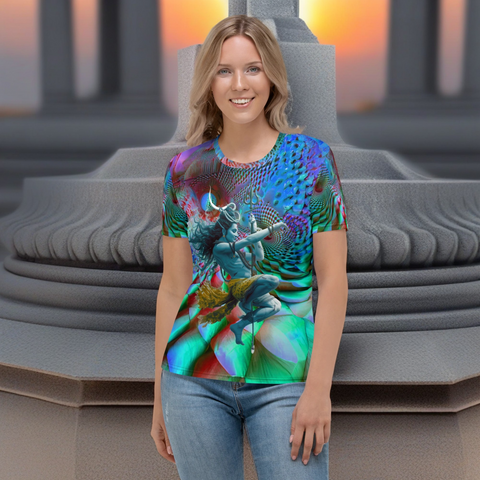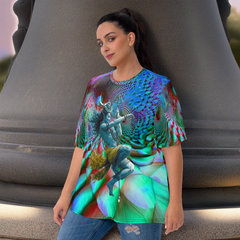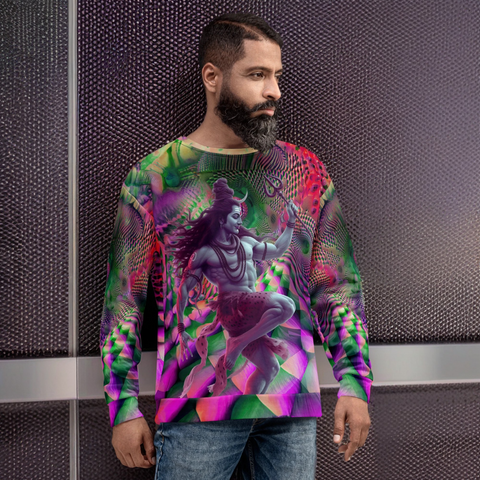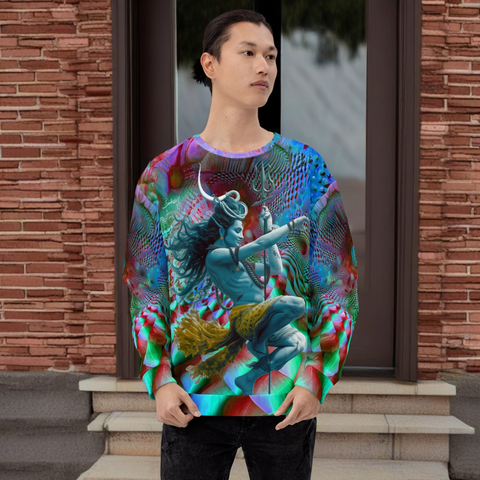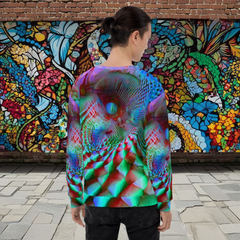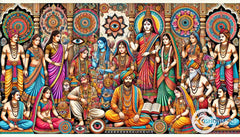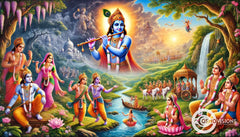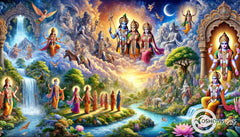Shiva Trident: Exploring the Divine Significance of Lord Shiva Trishul
Posted by Massimiliano Geraci
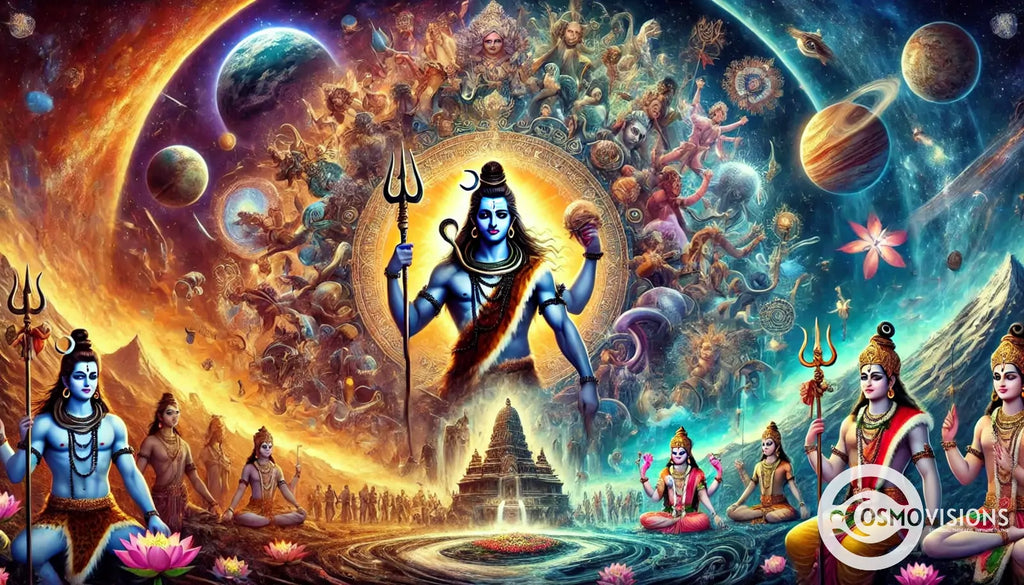
Many people find themselves drawn to the rich tapestry of Hindu symbolism, seeking to understand the deeper meanings behind sacred objects. The Trishul of Lord Shiva stands as a powerful emblem within this spiritual landscape, drawing devotees and scholars alike into its mystique world. The three blades of Trishool (Tri meaning three and Shool meaning spear) are believed to reperesent Brahma, Vishnu and Mahesh.
This ancient symbol harbors profound significance, intertwining with the very fabric of Hindu belief systems and rituals.
Intriguingly, Lord Shiva's Trishool is not just a destructive weapon but a representation of several core principles that uphold the universe according to Hinduism: creation, preservation, and destruction.
Our exploration will shed light on how this divine instrument guides individuals to enlightenment, offering insight into its role in meditation practices and how it embodies cosmic balance.
Join us to discover why the Trident is revered across temples in India and beyond. Discover the secrets within Shiva's symbol.
What is the Importance of Lord Shiva's Trishul?
Lord Shiva's Trishul holds deep symbolism in Hinduism, representing the deity's power to destroy evil and ignorance while preserving the balance of the universe. This trident signifies Shiva's role as the destroyer among the holy Trinity, alongside Brahma the creator and Vishnu the preserver.
Each point of the trishul represent Lord Shiva’s Trishul symbolizes a different aspect of life: creation, preservation, and destruction, reflecting his omnipotence over all worlds - Swarg Lok (heaven), Bhu Lok (earth), and Patal Lok (hell).
It also embodies three gunas or qualities present in human body and life: Satva (goodness), Rajas (passion), and Tamas (darkness). By wielding this powerful weapon, Lord Mahadev maintains harmony within human body represents the cosmos.
The Trishul is not just a symbol of destruction but also a reminder of peace, as it controls overindulgences that can lead to one's downfall. Its presence in worship practices points to self-realization by conquering desires and eliminating ego.
The significance extends into yogic practices where meditation on the Trishul can help achieve higher states of consciousness.
In every depiction of Lord Shiva, from ancient sculptures to temple carvings around India, you will find him armed with his mighty Trishul - a constant reminder that even gods choose their battles wisely for maintaining cosmic equilibrium.

What Does the Trishul Symbolize in Hinduism?
In Hinduism, the Trishul holds profound symbolism, encapsulating the essence of divine balance and power. This trident, wielded by Lord Shiva, serves as a beacon of dharma (righteousness), representing his role as the destroyer among the Hindu Trinity to maintain cosmic equilibrium.
The three prongs signify several triads: creation, maintenance, and destruction by Lord Brahma, Vishnu, and Shiva respectively; the three states, of wakefulness, dreaming, and deep sleep; and sattva (goodness), rajas (passion), and tamas (darkness) that are fundamental to Hindu philosophy.
Through its embodiment of these dualities and cycles within existence—births in Surya or solar energy manifestations cycled through day-nights—it transcends mere destructive weapon status to symbolize control over time (trikaal) itself.
The spiritual significance woven into its form extends further into personal aspects where it reflects upon inner realities—the soul's journey toward enlightenment amidst material life's challenges.
As such energies channel intentions toward liberation from Maya—the illusionary world—aspects like breath correlate with the human body and bodily functions on this path. Tools for meditation incorporating Trishula symbols encourage contemplation on these cycles of existence.
Deities beyond Shiva including Durga and Ganesha utilize variations expressing universal truths across contexts within diverse practices including yoga therapy which taps into similar triadic structures reflective in nature’s rhythms echoing cosmic dance narratives outlined in texts venerating these figures throughout history maintaining relevance today in shaping contemporary understandings on spirituality’s intersect with everyday lives ensuring beliefs remain integral across generations witnessing divinity mirrored in the physical world through art forms adorning sacred spaces dedicated to Shaivism pathways exploring depths unseen beneath surface interpretations inviting deeper connections.
How is the Trident Linked to Lord Shiva?
Lord Shiva wields the Trishul, a symbol of supreme divine power that pierces through ignorance and evil. This trident embodies Shiva's role as "destroyer of all the three states or lokas" and represents his control over the physical, metaphysical, and spiritual worlds.
Known for its association with the cycle of creation, preservation, and destruction, the Trishul holds deep significance in Hindu mythology, reflecting Shiva’s capacity to maintain balance within the universe.
Crafted by Vishvakarma, the divine architect, this powerful weapon signifies Lord Shiva’s authority over life and death. The three points of his Trishul symbolize various trinities—creation (Brahma), preservation (Vishnu), and destruction (Shiva) or satva (goodness), rajas (passion), tamas (darkness)—highlighting his omnipotence across all aspects.
Embraced by devout followers through symbols like Lingam adorned with marks resembling a Trishulkartikeya MurtiTrideviSaraswatiPatalaTripundraTandava in temples worldwide, it reinforces faith in Lord Shiva's ultimate power to eradicate darkness with light.

What are the Spiritual Meanings Behind Shiva's Trishul?
Transitioning from the link between Lord Shiva and his Trishul, the spiritual meanings behind this divine symbol emerge as a profound aspect of Hindu spirituality. The Trishul represents more than just a weapon; it is a powerful emblem encapsulating intricate metaphysical truths.
Each point of the trident symbolizes control over three aspects of existence: the physical, psychological, and spiritual dimensions. This triad reflects Shiva's dominion over the three Gunas (philosophy) - Tamas, Rajas, and Sattva - which are fundamental qualities inherent in all creation.
Furthermore, the Trishul's design holds deep significance in illustrating Lord Shiva's role as Mahesh, or the great destroyer and regenerator within Hindu cosmology. By wielding it, Shiva maintains balance in the universe by destroying evil forces and ignorance (represented by demons), thus paving way for new creation.
The presence of Damru (small drum) attached to it beautifully intertwines with the idea that all spiritual practice aims to merge individual consciousness with universal consciousness – Ātman with Brahman – echoing through its cosmic rhythm.
This sacred weapon serves many properties in mythological tales and also acts as a focal point during Puja (Hinduism), guiding devotees toward higher knowledge and understanding of their inner selves through meditation on the weapon held its symbolic depth.
How is Lord Shiva’s Trident Depicted in Temples?
In temples dedicated to Lord Shiva, the depiction of his trident, or Trishul, stands as a majestic symbol of divine authority and power. Craftsmen skillfully create these sacred artifacts from brass and embellish them with motifs signifying the sun god, the crescent moon, and sometimes a damaru tied near the trident held its base.
This representation honors Shiva as the destroyer of three lokas (worlds) and as a figure holding profound spiritual significance in Hinduism. The Trident's presence in these holy spaces serves as a constant reminder to devotees of Shiva's role as both protector and destroyer of third world.
Artisans position the Trishul within temple sanctums where it commands respect and adoration from followers. Devotees worship the Trident through prayers, often placing it behind or near the Shiva Linga, symbolizing Lord Shiva's energy force.
The intricate designs carved onto each Trishul detail stories from ancient Puranas – tales that narrate Lord Shiva’s victories over demons using this mighty weapon. These depictions foster devotion while educating believers about Hindu dharma’s complex layers.
The Trishul stands as a weapon and as a beacon of faith, guiding souls toward liberation.
What Are Common Representations of the Trident in Temples?
In Hindu temples dedicated to Lord Shiva, the trident symbolizes his power and divine authority. Craftsmen often sculpt Shiva's trishul alongside depictions of other deities of the deity, capturing its essence as both a weapon and a spiritual object.
This trident represents the destruction of negativity and evil and stands as a reminder of Shiva's role as the destroyer among the Hindu Trinity. Devotees view these representations with deep reverence, understanding their significance in relation to cosmic balance.
Many temples also showcase the trishul entwined with serpents or adorned atop Nandi, Shiva’s loyal bull. These elements further enrich its symbolic meaning—serpents signify Kundalini energy lying dormant within humans while Nandi embodies steadfast devotion.
Such intricate details in temple iconography offer insights into Hindu philosophy’s complex layers, touching upon themes of creation, preservation, and dissolution embodied by Lord Vishnu and Lord Brahma alongside Shiva.
These visual narratives foster a profound spiritual connection, between devotees and the spiritual messages intertwined within the physical form of the trident.
How is the Trident Showcased in Shiva Temples?
In Shiva temples, the trident or 'Trishul' holds a place of honor as a divine emblem representing Lord Shiva's power and authority. Craftsmen intricately carve these sacred symbols into stone, metal, and wood, placing them prominently beside the deity’s idol.
Some are even installed independently within temple grounds, reaching impressive heights that command respect and reverence from devotees who visit. These tridents embody the destruction of negative forces embodied by Tamas (philosophy), guiding worshippers to spiritual liberation.
Temples showcase the Trishul not just as an object of veneration but also embed its imagery in architectural designs and decorations surrounding Lord Shiva's sanctum. Devotees often adorn the trident with flowers, bilva leaves - thought to be dear to Shiva - and drape it in fabrics during worship rituals, emphasizing its significance beyond a mere weapon; it symbolizes protection against ignorance and illusion leading to enlightenment.
This ceremonial prominence highlights how deeply entwined the Trishul is with practices honoring Shiva as both a destroyer of evil and protector of the universe.
How Do Devotees Worship the Trishul?
Devotees view the Trishul as a symbol of Lord Shiva's power and his role as the destroyer of evil. They incorporate various rituals and practices to worship this divine instrument, acknowledging its great significance in Hindu spirituality.
1. Offering prayers: Devotees often start their worship by offering prayers to the Trishul, acknowledging it as a powerful symbol that protects them from negative effect and evil forces.
2. Performing puja: Puja ceremonies directed at the Trishul involve offerings of flowers, incense, and sometimes food items, recognizing it as an embodiment of Shiva’s energy.
3. Chanting mantras: Specific mantras dedicated to Lord Shiva are chanted in front of the Trishul, empowering individuals with spiritual strength and peace.
4. Meditating on its symbolism: Followers meditate on the symbolic meanings behind the Trishal—destruction of ego, ignorance, and imperfections—to cultivate clarity, wisdom, and understanding in their lives.
5. Decorating with vermilion: Devotees often apply vermilion paste on the trident as a mark of respect and devotion, symbolizing purity and protection.
6. Participating in festivals: During significant festivals like Mahashivratri, devotees gather around representations of the Trishul in temples or create altars at home to celebrate its divine qualities.
These practices enable worshites to engage deeply with the trident's spiritual essence. Next comes understanding how this revered symbol finds a place within personal meditation practices.
What Are the Myths and Legends Associated with Lord Shiva’s Trident?
Legends tell us that the same trident held up by Lord Shiva, known as Trishul, holds immense power and is not just a weapon but a symbol deeply embedded in Hindu mythology. It represents the three Gunas—Sattva, Rajas, and Tamas—essential attributes believed to be present within every human being. Additionally, Lord Shiva's neck is adorned with a snake symbolizing the energy and power he wields.
Shiva's Trishool destroys the three lokas (worlds)—Svarga (heaven), Bhuloka (earth), and Patala Lok (netherworld)—underscoring its significance as a tool for maintaining balance in the universe. The trishool formed from the merging of solar matter and divine energy, represents holiness and the main centre of consciousness experienced by all beings.
This aspect highlights Shiva’s role as a destroyer and creator of the universe, illustrating his control over life and death. The myths surrounding Lord Shiva's Trident weave tales of valor and strength. For instance, it was with this mighty weapon that Lord Shiva severed Ganesha's head and defeated Asuras (demons) threatening cosmic harmony, embodying the force capable of vanquishing darkness and evil from all three worlds.
These stories, recounted in texts like the Vishnu Purana, serve to reinforce Shiva’s position as one of the principal deities in Hinduism alongside Vishnu—who wields the Sudarshan Chakra—and Brahma—the creator deity—with whom he forms the Divine Trinity or Trimurti responsible for creation, preservation, and destruction within Hindu cosmology.
Each tale associated with the Trident glorifies its divine qualities and deepens devotees' understanding of Shiva’s multifaceted nature as both Nataraja (Lord of Dance), symbolizing endless cycles of existence, and Parvati’s consort, exemplifying ideal companionship. The energy reaches the devotees through Shiva, influencing their positive outlook and good deeds, regardless of external happenings. The best example of this divine influence is seen in the parts Ida, representing the left energy channel of the human body.
What Are the Popular Stories Surrounding the Trident?
The trident, or Shiva's trishul, carries deep mythological significance in Hinduism. It symbolizes Lord Shiva's power and the balance of the cosmos.
1. Creation of the Trishul: Shiva's tridant was crafted by Vishwakarma, the divine architect of gods. This event signifies the materialization of divine energy into a tangible form that can govern and protect the universe.
2. Destruction of Daksha’s Sacrifice: Lord Shiva used the trishul to destroy Daksha's yajna (sacrifice), demonstrating its ability to disrupt cosmic order for restoring dharma (righteousness).
3. Conquest over Demons: The trishul is instrumental in Lord Shiva's defeat of demons such as Andhaka and Tripurasura, representing the triumph of good over evil and illustrating its role as a weapon against darkness.
4. Symbolism with Lakshmi and Parvati: The trishul represents three aspects – creation, preservation, and destruction – linked to goddesses Lakshmi, Parvati (Shiva’s consort), and Saraswati respectively. This highlights its connection to both male and female divine forces.
5. Significance in Samudra Manthana: During the churning of the ocean (Samudra Manthana), Lord Shiva holds his trishul to stabilize Mount Mandara, showing its importance in maintaining cosmic equilibrium.
6. Association with Ātman: The trident symbolizes the journey toward realizing one's Ātman (soul) by overcoming physical desires represented by its three prongs - Sattva (goodness), Rajas (passion), and Tamas (darkness).
7. Integration in Yoga Practices: Practitioners meditate on the trishul within their body’s spiritual centers, aligning their energies with universal vibrations to attain spiritual awakening.
8. Sravana encodes complex concepts about human existence into an accessible symbol that followers can integrate into personal worship practices for enlightenment.
9. Legends Beyond Hinduism: Versions of stories involving a powerful trifecta weapon appear beyond Hindu texts, hinting at a broader cultural appreciation for tri-pointed symbols representing balance and supremacy across various traditions.

How Does the Trident Feature in Hindu Mythology?
In Hindu mythology, Lord Shiva's trishul stands as a mighty symbol of divine authority and power. Legends depict it as an invincible weapon capable of destroying all forms of evil and ignorance the whole world.
This trident signifies Lord Shiva's role as the destroyer in the Hindu Trinity and also embodies the integration of the physical, mental, and spiritual aspects. Stories abound where Shiva wields his trishul to vanquish demons threatening cosmic balance, highlighting its great significance in maintaining dharma (righteousness) across the universe.
Crafted from divine materials, including the damru tied at its neck, this three-pronged spear symbolizes control over three time periods — past, present, and future— and is revered in stories for its ability to eradicate darkness with light.
Each prong represents one fundamental aspect of life: creation, preservation, and destruction; mirroring Shiva’s deep connection with Ātman (the soul), material world aspects represented by pataal lok (the netherworld), and human existence through Gunas (qualities).
As we explore further into understanding this celestial tool’s essence in temples dedicated to Lord Shiva, we see many properties of how devotees venerate it as a central object of their faith.
What is the Spiritual Significance of the Trishul in Personal Worship?
The Trishul holds profound spiritual significance in personal worship, serving as a potent symbol of Lord Shiva's power and the divine balance within the universe. Devotees meditate on this emblem to connect with the higher aspects of consciousness and harness the energies represented by its three points - creation, preservation, and destruction.
These aspects align with the human body's capacity for harmony and transformation, allowing worshippers to embody the purity and strength that Lord Shiva signifies. Engaging with this symbol through meditation or incorporating it into yoga practices enables individuals to explore deeper aspects of spirituality, where they can confront their inner shadows under Lord Shiva’s guidance.
Meditation focusing on the Trishul symbolizes an aspiration towards achieving a state of equilibrium between mind, human body represents will, and spirit. Practitioners use this sacred instrument as a means to transcend ordinary experiences, aiming for liberation from life's cycle of suffering.
Through regular engagement in such spiritual exercises, one cultivates three qualities essential for enlightenment—discipline, focus, and understanding of Ātman (Hinduism), recognizing oneself as part of a grand cosmic play guided by divine forces like those embodied by Lord Shiva’s Trishul.
How Can One Meditate on the Symbol of the Trident?
Meditating on Lord Shiva's trishul allows for a profound spiritual connection, with the divine. Start by visualizing the trident, symbolizing the three Gunas—Sattva (goodness), Rajas (activity), and Tamas (darkness).
These are essential Hindu concepts explaining personality traits and behaviors. Focus your mind on balancing these forces within you, aiming for mental and physical world and spiritual harmony.
Meditation practices often incorporate symbols to deepen one’s focus and understanding. Visualize the trishul as not just a weapon but as a reminder of balance and inner strength.
Contemplate its significance in destroying ignorance and promoting wisdom, happiness, and enlightenment. This approach transforms meditation into an act of worship, aligning personal energy with cosmic vibrations.
The trishul represents mastery over the physical, mental, and spiritual worlds.
What is the Role of the Trident in Yoga and Meditation Practices?
In yoga and meditation practices, the image of Lord Shiva's trishul represents spiritual growth, protection, and the balance of three gunas—Sattva, Rajas, and Tamas. Yogis use this symbol to focus their minds on achieving a state of equilibrium within themselves.
By visualizing the trident during meditation or incorporating it into certain yoga poses, practitioners aim to transcend beyond physical limitations to mental world and attain inner peace. This act of meditative focus helps in aligning one’s energy with universal vibrations, aiding in the pursuit of enlightenment.
The trishul means the role extends further as the trishul signifies breaking through ignorance with knowledge (Sattva), action (Rajas), and inertia (Tamas). Engaging with this symbolism encourages individuals to confront inner conflicts and promotes spiritual healing.
Transitioning into deeper aspects explores how each point of Lord Shiva’s trident can guide an individual toward realizing their highest potential. Reflecting on these elements during practice supports cultivators in advancing their spiritual journey more consciously.
How Does the Trident Represent the Concept of Trinity in Hinduism?
The Lord Shiva Trishul stands as a powerful symbol in Hinduism, embodying the concept of Trinity or 'Trimurti' through its three prongs. Each point is thought to represent one aspect of the triad - Brahma the creator, Vishnu the preserver, and Shiva himself as the destroyer or transformer.
This trinity reflects Hinduism's intricate beliefs in creation, preservation, and destruction as essential forces governing the universe. The tool highlights how these three fundamental aspects work in harmony to maintain cosmic balance.
Tying this symbol back to spiritual practices, followers see the Trident not just as a weapon wielded by Lord Shiva but also as an emblem of wisdom that controls all aspects of life governed by time—past, present, and future.
It encapsulates key principles such as 'symbolize the three,' emphasizing how physical existence hinges on these universal functions. Devotees meditate on this imagery to grasp deeper spiritual truths within Hindu philosophy; henceforth transcending mere religious iconography and cementing itself into personal worship rituals where understanding and enlightenment become paramount.
What Does Each Point of the Trident Symbolize?
Each point of Lord Shiva's trident represents a fundamental aspect of the universe, embodying the principles of satva, rajas, and tamas. Satva points to qualities like goodness, calmness, and harmony that are essential for spiritual enlightenment.
Rajas symbolize energy, action, and change driving the creation within the cosmos. Tamas reflects qualities of darkness, inertia, and chaos necessary for destruction before regeneration can occur.
Together these forces maintain the balance in the universe as reflected in Hindu beliefs.
Furthermore, this iconic symbol intertwines with other aspects of spirituality such as the damru or drum attached to it which denotes Shiva's connection with sound - considered to be the origin of language in Hindu mythology.
Through its representation across various mediums from temple sculptures to religious iconography among Hindu deities on platforms like Amazon (company), each element opens a pathway for believers into deeper aspects of consciousness exploring beyond mere religion inch by dashboard toward an experiential understanding of existence.
Transitioning smoothly into how this trinity connects back to broader concepts within Hinduism leads us right into exploring how deeply intertwined Shiva's trident is with notions of cosmic balance and order.
How is the Trident Connected to the Hindu Trinity?
The Trident, also called Trishul, embodies the symbolism behind the Hindu Trinity of Brahma, Vishnu, and Shiva. Each point of the Trident represents one aspect of this triad: creation (Brahma), preservation (Vishnu), and destruction or transformation (Shiva).
This powerful emblem highlights the interconnectedness and balance within the universe's cycles. By wielding the Trishul, Lord Shiva underscores his role in maintaining cosmic harmony through these processes.
In this alignment with cosmic forces, the Trishul also symbolizes the three fundamental qualities or Guṇas present in nature and human life: Sattva (blissful life, goodness, constructive, harmonious), Rajas (passion, active, confused), and Tamas (darkness, destructive, chaotic).
These forces are essential for evolution and change to occur within creation. Through meditation on Shiva's primary weapon, —the trident— devotees can embody these universal principles themselves.





